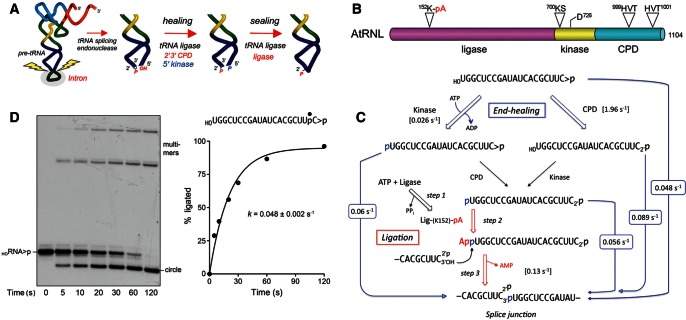FIGURE 1.
Pathway and kinetics of end healing and sealing by tRNA ligase. (A) Splicing pathway. The pre-tRNA is cleaved at the exon–intron junctions in the anticodon loop by a tRNA splicing endonuclease, which leaves a 2′,3′-cyclic phosphate end on the proximal half-molecule and a 5′-OH on the distal half-molecule. In yeast and plants, the ends are healed and sealed by tRNA ligase, a multifunctional enzyme with 2′,3′-cyclic phosphodiesterase (CPD), 5′-OH polynucleotide kinase, and ATP-dependent ligase activities. The residual 2′-PO4 at the splice junction is eventually removed by the NAD+-dependent 2′-phosphotransferase Tpt1. (B) Arabidopsis tRNA ligase is composed of an N-terminal ligase module, a central 5′ kinase module, and a C-terminal CPD module. The site of covalent adenylylation at the ligase active site, the P-loop motif and aspartate general base at the kinase active site, and the two HxT motifs that comprise the CPD active site are highlighted. (C) The chemical steps of AtRNL-mediated healing and sealing of a HORNA>p substrate are shown. The rate constants for the individual steps or subsets of steps (denoted by arrows between input substrate and product) that were measured under single-turnover conditions in the present study are indicated. (D) Single-turnover OHRNA>p ligation. Reaction mixtures containing 50 mM Tris-HCl (pH 8.0), 50 mM NaCl, 10 mM MgCl2, 0.1 mM ATP, 2 mM DTT, 20 nM HORNA>p substrate (shown at top right with the 32P label denoted by •), and 1 µM AtRNL were incubated at 22°C. Aliquots (40 µL) were removed at the times specified and quenched immediately with an equal volume of 90% formamide, 30 mM EDTA. The products were resolved by electrophoresis through a 20% polyacrylamide gel containing 7 M urea in TBE. An autoradiogram of the gel is shown in the left panel. The positions of the input substrate and the ligated circle and multimer products are indicated. The extent of ligation ([circle + multimers]/total RNA) is plotted as a function of time in the right panel. Each datum is the average of three separate time-course experiments ±SEM. A nonlinear regression curve fit of the data to a single exponential is shown.

